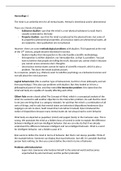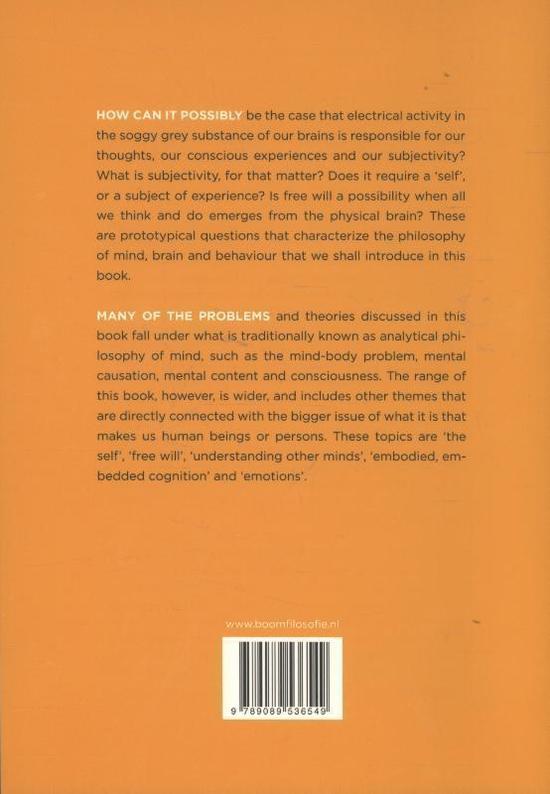Hoorcollege 1
The mind is an umbrella term for all mental states. Mental is intentional and/or phenomenal
There are 2 kinds of dualism
- Substance dualism: says that the mind is a non-physical substance (a soul) that is
causally connected to the body
- Property dualism: says that the mind is produced by the physical brain, but some of
its properties (phenomenal properties; all conscious states are phenomenal states, all
are subjective, inter qualitative) are non-physical
However, there are some methodological problems with dualism. This happened at the end
of the 19th century, people became interested in science.
- Dualism implies that introspection is the only feasible scientific methodology
- Introspection is neither objective, nor intersubjective, so that is a problem. You just
have to believe that people are telling the truth, because you cannot check it because
you cannot access someone else’s thoughts.
- Unconscious mental states cannot be topics of scientific research, which is also a
problem. This blurs the whole dualistic picture.
As a response, people (e.g. Watson) want to redefine psychology as a behavioral science and
not talk about the mind anymore.
Logical behaviorism (this is another type of behaviorism, but this is from philosophy and not
from psychology). They also saw problems with dualism. But they looked at it from a
philosophical point of view, and they noted the interaction problem: this states that the
mind and body are capable of causally affecting each other.
Gilbert Ryle wrote a book called The Concept of Mind, which is a conceptual analysis of the
mind. He wanted to add another objection to the interaction problem. He said that the mind
is not just one thing (that is a category mistake), he said that the mind is a combination of all
sorts of things, and he said that mental states are behavioral dispositions/tendencies (dus
neigingen om iets te doen, heeft zowel direct als indirect invloed). Ryle introduced the
notion of dispositions because many mental states do not always lead to overt behavior.
Mind body are depicted as pupetteer (mind) and puppet (body) in the Cartesian view. This is
wrong. We postulate the mind as a hidden locus of control in order to explain the difference
between intelligent and non-intelligent behavior. But we can only do that if we already
understand the difference between intelligent and non-intelligent behavior. Mind is a word
for intelligent behavior, not a hidden cause of it.
Ryle wants to define the mind in terms of behavior. But that is not always possible. Think of
the example below. Someone can display that exact behavior, but still, it is possible that that
person feels nothing. So then you cannot define the mind in terms of behavior.
Problems with behaviorism
- Super stoic (someone who hardens himself to the external world and becomes
unperturbed by external chaos) and the perfect pretender
, - Mental holism (no question in the exam about this)
Identity theory (1.3)
Ullin Place introduces Boring to philosophers such as J.J.C. Smart. This was a really new and
radical way of thinking, kind of a revolution in England. In Australia, people were less
enthusiastic about this theory.
Smart said: “the mind is as manipulable as the brain”.
Theory
- Mentalistic language is topic neutral
- Dualism may have been true, but it isn’t because people found results that show that
it isn’t true.
- Mind = brain (so they are identical)
- This is a scientific discovery comparable to: water = H2O
However, there are 2 problems with this theory
1. The explanatory gap: stating that mental states are brain states actually doesn’t
explain anything. How can intentionality and phenomenality be physical? The water =
H2O example is not convincing enough.
2. Multiple realization: according to the identity theory, organisms with different brains
cannot have the same types of mental states. However, this is unlikely, think of pain.
A cow can experience pain just like a human can.
There will be no questions on the differences between type-identity theory and token-
identity theory.
Antwoorden multiple choice lecture 1
1: D
2: B
3: B
, Hoorcollege 2
Functionalism: the basic ideas
- Do not define mental states in term of what they are made of
- Define mental states in terms of what they DO: what is their function for an
organism?
- Compare the concept of carburetor
Causal role-concept: a mental state (M) can be defined in terms of:
1. The sensory inputs, that causes M
2. The actions that are caused by M, against the background of
3. The other mental states had by the same person
For example, my belief that it rains outside, it caused by looking outside, causes me to grab
an umbrella, against the background of my desire to stay dry and my belief that an umbrella
will keep me dry.
The explanatory gap: how can a thought be electrical activity in grey, soggy matter? A
functionalist answer would be:
1. Define thought as a causal role
2. Find a brain state that plays that role
3. That brain state is the realizer of the thought
Roles and realizers
A parallel example: Mendel postulated the existence of genes, Watson and Crick discovered
DNA. ‘Gene’ is a causal role concept, ‘DNA’ is the realizer of genes.
Multiple realizability is possible in functionalism. They say that the same causal role can be
realized in different ways. The same causal role can be played by multiple realizers.
Computationalism (end of 1970s). Fodor was the inventor of this. He says that this is the
only real theory, and a lot of people actually believed this, so it was very influential.
Thinking machines: if a system contains symbols that represent states of affairs in the world,
and if these symbols are manipulated according to a given syntax that respects their
semantic properties, then such a system can draw correct conclusions about the world IF it
starts with correct assumptions. Such a system can think!
Human thought: the brain is a biological computer. The mind is the software of the brain.
The syntax of the brain is ‘the language of thought’.
Searle’s Chinese room argument: the room is not connected with the outside world, there is
a person sitting in there, he doesn’t speak Chinese, he has a book that is about Chinese
symbols and how to manipulate them. People outside the room ask questions and slide a
paper inside the room, then the person inside the room answers that question with the
book, because the book instructs the person in the room how to answer the others. The
book is organized in a clever way, so the people outside the room really get the idea that the
thing or person inside the room is a very intelligent Chinese speaker.






